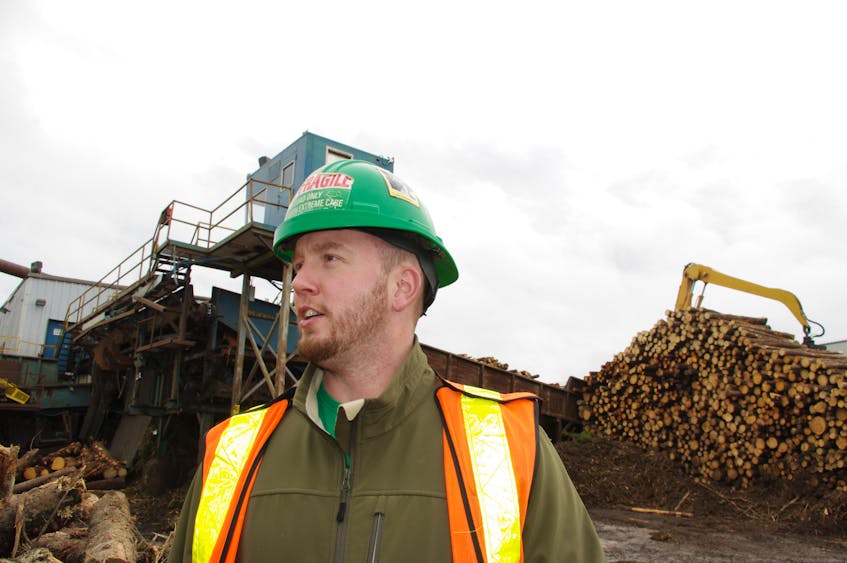SCOTSBURN, N.S. — On Tuesday morning, Craig Tupper was on a conference call with some of the Athol Forest Co-op’s 250 Cumberland County woodlot owners.
The forester didn’t have good news.
“The impact (of the announced Northern Pulp shutdown) was immediate,” said Tupper.
“Landowners have seen a massive drop in stumpage.”
Clearcut 'only type of harvest that’s really viable'

The drop in stumpage prices paid for studwood and the lack of a market for pulpwood has caused Tupper to put a hold on progressive forest management programs like commercial thinnings on the 18,000 hectares managed by Athol.
The numbers on the type of ecological forestry advocated by the Lahey Report and which the Department of Lands and Forestry has been working toward implementing, don’t add up anymore.
“A clearcut or something closely resembling a clearcut is now the only type of harvest that’s really viable because they will need to take the best material out of each stand to make it viable,” said Tupper.
“I think people are thinking that the pulp mill going is good because there will be less forest harvesting. They will actually see less of the stand improvement work that the public wants to see.”
Thinning receding
A commercial thinning is part of a series of treatments that foresters like Tupper have been pushing landowners towards over recent years. A harvester cuts paths through a woodlot while reaching into the stand on either side grabbing crooked or short-lived trees like balsam fir, poplar and white or grey birch.
They leave behind the longer-lived, higher value trees like red spruce, pine, hemlock, yellow birch and sugar maple. The forest canopy is maintained for those trees to seed in the swaths cut by the harvester while also opening up room for them to grow tall and straight. Wildlife habitat is maintained while ultimately creating a higher valued resource in decades to come.
“We have a lot of degraded forest from 400 years of harvesting. Until recently, it was take the best and leave the rest,” said Tupper.
“Over recent years we’ve been seeing some progress on changing that attitude with more partial harvests and forest improvement happening.”
The day before Premier Stephen McNeil announced he wouldn't extend the deadline contained within the Boat Harbour Act and Northern Pulp also stated it would shut down, a commercial thinning on a typical 20-hectare woodlot would net a landowner about $15,000. A clearcut on the same lot would have netted about $28,000, if the landowner didn’t go for Tupper’s pitch that they would have a significantly more valuable forest in a few decades.
Studwood prices tanking

The day after the province's decision on Boat Harbour, studwood prices dropped and the market for pulpwood disappeared.
So the 250 cords of studwood on that theoretical commercial thinning went from being worth $12,500 to $5,000 to the landowner. The 300 cords of pulp became worthless but leaving it stand to seed in the cut area would negate the purpose of a commercial thinning.
A clearcut under the new stumpage regime would net the landowner about $11,200 and leave more of the shorter lived trees that are susceptible to blow downs.
“I’m telling people to sit on their lots if they can,” said Tupper.
Though Eric Williams gets that advice, it’s concerning to him.
The co-owner of Williams Brothers Sawmill in Barneys River needs logs.
Thirty per cent of the logs milled there came from Northern Pulp. So that supply is gone along with further supply as landowners sit on their lots.
In a way, though, he’s fortunate.
Williams sells his woodchips, a byproduct of sawing lumber, to Port Hawkesbury Paper.
The next closest sawmill, Scotsburn Lumber in Pictou County, also has reached a short-term agreement to sell their chips to the mill at Point Tupper, which consumes about 600,000 tonnes annually (as opposed to Northern Pulp’s 1.1 million tonnes).
Ledwidge Lumber in Enfield and the Irving-owned Sproule Lumber in Valley, Colchester County, are studwood mills like Scotsburn and are also seeking new markets for woodchips.
“For the last several years within our overall supply arrangements, PHP has had fiber supply and exchange agreements with Northern Pulp,” said Andrew Fedora, leader of sustainability and outreach for Port Hawkesbury Paper in a written response.
“During the summer of 2019, PHP consulted on a contingency basis across the supply chain to determine how our relationship with Northern Pulp could be balanced if Northern Pulp were to cease operations. With the announced closure of Northern Pulp, PHP is activating those contingency agreements to fill the gap that will be created as our supply and exchange agreements with Northern are no longer possible.”
How much of the slack in the pulp market Port Hawkesbury Paper can pick up remains to be seen.
RELATED:
- Nova Scotia government silent on implementing Lahey report without Northern Pulp
- Northern Pulp fallout continues
- Determination, defiance in hard-hit Pictou County in the wake of Northern Pulp announcement
- LETTERS: Readers divided on Northern Pulp decision
- BACKGROUND: Expected Northern Pulp, Boat Harbour decisions come after years of controversy









